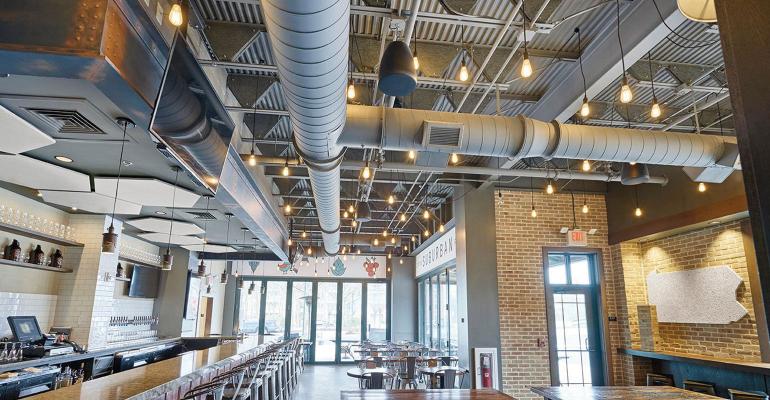Sponsored by Armstrong Ceiling & Wall Solutions
On the perimeter of the dining room at Johnny’s Italian Steakhouse restaurants, curtains divide four-tops, giving customers the option to be enclosed in privacy and quiet while they dine.
“To our surprise it’s the most requested section in the restaurant,” says Ajay Singh, vice president of brand development for the Moline Ill.-based chain.
“Loud” has lost its popularity with restaurant customers. While a lively, busy hospitality space is appealing, too much noise is a turn off for diners. For the second year in a row, noise remains a top complaint in the annual National Dining Trends Zagat survey. The 2018 consumer study found that noise got the highest complaint, followed by service, crowds, high prices and parking.
Restaurant operators are rethinking sound and looking for ways to improve the customer experience without sacrificing design and that energetic atmosphere restaurants need to stay successful. Keeping that balance is a matter of addressing different aspects of restaurant design and their impact on sound.
Why so loud?
While the modern design of an exposed structure space along with concrete floors gave the Suburban Restaurant and Beer Garden in Exton, Pa., an energetic vibe, customers complained about noise when it opened, says chef-owner Eric Yost. The noise level in the restaurant was compared to dining on an airport tarmac.
“The hard surfaces may not have been the best materials for controlling sound, but that’s the look we were going for,” Yost says.
Generally speaking, the harder the surface, the more noise bounces and reverberates around a dining room and bar, note industry experts. One contributing factor over the last decade has been the improvement of porcelain floors to replicate the look of wood floors or stone, says New York restaurant architect and designer Garrett Singer. While easy to maintain, durable and cost effective, they are an even harder surface than wood, leaving sound to bounce back up rather than to be absorbed into the floor.
The sizes of restaurants have also decreased over the years, from an average of 10,000 to 12,000 square feet down to an average of 8,000 to 6,500 square feet, says Boulder, Colo., architect Tim Trapp. The same number of people in a smaller space has the potential to get very loud.
“Most dining is social,” Trapp says. “Eating is a part of it and conversation is a part of it. The ability to do that — hear and listen and speak — influences the success of that experience of going out to eat.”
The challenge is to control noise but still maintain aesthetically pleasing surroundings. Mostly it’s a matter of addressing the restaurant surfaces — ceiling, walls and windows, and the floor, say restaurant designers.
“You want to stop the noise bounce, but at the same time, you don’t want to suck up all the energy that is there,” Trapp says.
The ceiling
Alberto Flores loved the high, exposed ceiling and industrial look of the 2,200-square-foot space for his Bert’s Bottle Shop restaurant and bar in Millersville, Pa. However, because of the size and surfaces, sound bounced excessively throughout the restaurant, even when there was only a small group of customers.
Acoustic measurements showed the average reverberation time was 1.4 seconds, above the industry recommended level of 0.8 to 1.0 seconds, reports Armstrong Ceilings. However, after the installation of 416 square feet of acoustical ceiling panels attached to the deck, the sound reverberation dropped by 36 percent to 0.9 seconds. Customers never noticed the panels that blended in with the ceiling, Flores says. However, they did comment on being able to hear conversations and not have to shout to one another.
“It was noticeably quieter right away,” Flores says. “It made the space feel more solid and less like a tin box while keeping the on-trend exposed visual.”
The walls
To address the noise problem at the Suburban Restaurant and Beer Garden, Armstrong Ceilings installed acoustical panels above the bar. However, treatments to the restaurant’s walls also impacted sound levels. To help deal with the problem, a large panel in the shape of the state of Pennsylvania was created out of a textured wood fiber panel and attached to a main wall, along with images of the beer garden’s logo printed on other acoustical wall panels around the room.
Sound improved without interfering with the restaurant’s design, Yost says.
Other options for operators can include acoustic panels arranged to look like murals rather than sound solutions. Curtains can also help to soften noise, either at windows or along walls, New York architect Singer says. Sound strongly reverberates against windows, bouncing back into a room.
The floor
The carpet industry also has made strides in devising durable, stain-resistant, innovative floor coverings, Singer adds.
“Carpet eliminates the sound of people walking, chairs sliding in and out, forks or knives dropped to the floor,” he says. “It’s a way to deaden sound but not knock it down to where it’s too quiet.”
After treating hard surfaces with the right acoustic features to balance noise, the sounds restaurateurs are hearing are compliments from customers about their dining experience.
“Our ambiance now is very conducive to conversations, which is what we wanted in the beginning,” says Singh from Johnny’s Italian Steakhouse. “When you come in on a busy night, you see our guests engaged in dialog and conversation.”




